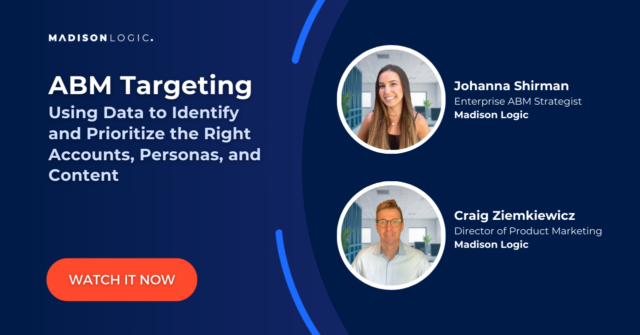
Success in an account-based marketing (ABM) strategy hinges on targeting and engaging the right audience. But even with a solid grasp on your target account list, you still need more insights to identify and engage the key buyer personas in a purchase decision.
Why?
There are a few factors. First, buying groups are larger—while the typical buying committee consists of four to six members on average, Gartner finds that for a complex B2B purchase there could be as many as 14 to 23 individuals involved in the decision-making process. These buying committees are typically composed of various stakeholders, each with their distinct influence on the purchasing decision. These may include end-users, influencers, decision-makers, and gatekeepers. Members need to come to a unanimous decision on which solution to choose, so it’s up to you to uncover who those key players are so you can surround them with content and messaging that educates them about your solution.
Additionally, buyers increasingly expect more personalized experiences that speak to their specific needs and pain-points. Mapping personalized content to where individuals are in the buyer’s journey is the most effective way to present them with the content and messaging needed to motivate them through the funnel and get them to a decision faster.
And lastly, digital, self-guided, non-linear customer journeys have become the norm. McKinsey research finds that buyers regularly use ten or more channels to research and engage with content. Considering up to 90% of the buyer’s journey is completed before a prospect reaches out to a salesperson, it’s up to marketers to engage key decision-makers and build brand awareness for a solution with a targeted digital marketing strategy.
With all these factors in mind, B2B marketing teams must be more strategic and purposeful with their digital marketing content and campaigns to maximize their efforts and reach their revenue goals. This starts with a deeper understanding of the personas to engage across the buying committee and what content is most likely to convert. Let’s dive into what you need to inform your target and activation strategy so you can target and engage the right key buyer personas.
Leverage Intent Data to Inform Your Target & Activation Strategy
Inefficient targeting is a big driver of poor results and ROI. At a time when marketers are increasingly being asked to do more with less, better targeting with available data is an important area to focus on. You not only need to use your internal data sources from your customer relationship management (CRM) system and marketing automation platform (MAP) but also external third-party and behavioral data sources to build a comprehensive scoring system to understand your target audience and how to engage them.
According to Gartner, organizations using intent data are two times more likely to have a 10% conversion rate. Intent data is essential to ABM because it not only tells you what accounts are actively in the buying process based on their online research and content consumption behavior, but also who are the key stakeholders in the decision-making process.
The key intent data sources to use include:
- Owned Data: This is your first-party data found in your CRM and MAP.
- Media Engagement Data: External behavioral data that highlights media targeting investments and buyer engagement with activation channels.
- Technographic Data: Information about the account’s tech stack installs and investments that allows you to understand complementary and competitive software and hardware use.
- B2B Research Data: Insights into prospect product research across B2B websites and what content they’re consuming.
When you combine these data sources, you gain a better understanding of in-market accounts so you can identify which buyer personas to target across the buying committee, and what content and messaging to use to engage them.
Map Buying Group Members and Their Roles and Needs
Start by figuring out your buying committee size in your target customer accounts. The size of the account will help inform how large the committee will be—if it’s a larger company, your buying committee may be larger than at a smaller company with less people making the purchase decision. Sales insight is a great resource here to reveal what the common size or composition is for similar and current customer accounts so be sure to keep your sales team involved in your buyer persona mapping task. Market research and analyst insights can also be helpful sources at your disposal to pinpoint the average number of team members making the purchase decision and the types of buyers involved.
Once you’ve narrowed down the size of the buying committee, determine the different buyer personas to create a map of who they are and what they care about. Keep in mind that each buyer persona typically has their own pain points and concerns. An end user will care about functionality, while the technical buyer is going to be more concerned with security and how the solution fits into the company’s existing tech stack. List out the basic demographic information about each role, like job title and department, and use data to uncover the rest of the buyer persona profile.
Now it’s time to dive deeper. Leverage both your first-party data from direct interactions (sales insights, CRM data, lead/form fill information) and third-party intent data to gain a deeper understanding of each buyer persona’s needs and interests.
For instance, B2B research data that reveals persona product research activity across B2B websites informs the pain points, interests, and concerns for your content marketing strategy.
One important thing to watch out for when identifying and mapping target personas is to avoid becoming too focused on one persona with your marketing messages. We often see marketers focus on IT members of the buying committee because that’s an area where a lot of information is available. The problem with this approach is that multiple stakeholders across various departments and seniorities influence buying decisions. That’s why we need to use buyer personas. Those who reach all stakeholders to maximize brand awareness increase their likelihood of securing the deal because you’re able to create a consensus opportunity for each buyer persona and committee member.
Using data to understand these nuances among the buyer personas—along with where they are in the funnel—will allow you to create a more personalized customer experience through your content and messaging.
Match Content to Buyer Personas and Funnel Stage
Each buying committee member has their specific concerns and wants to find a viable solution to solve them. The end user who will likely use your solution every day will have different concerns from an executive-level decision-maker. Thus, you need to tweak your content marketing strategy to reflect each persona. A good rule of thumb is to repurpose existing content with specific messaging for each buyer persona you identify. Data-driven insights around these individual concerns will help you determine the type of content and topics that educate them about your solution and move them through the buyer’s journey faster, so they select you as the ideal solution to help them reach their goals.

For example, technical buyers may value detailed whitepapers on product specifics, while decision-makers might prefer ROI case studies showcasing your solution’s impact on similar businesses. Use data insights to determine where each buyer persona spends their time online and choose the most effective channels for content distribution. For example, Forrester insights tell us that CEOs use social media frequently to research solutions through their buying journey, so you will want to make sure you’re reaching these personas with messaging that speaks to their specific concerns through LinkedIn Ads.
Keep in mind that the journey from awareness to a decision often involves multiple touchpoints. Mapping personalized content to where individuals are in the buyer’s journey is the most effective way to present them with the content and messaging needed to get them to that decision faster. Not all personas progress through the funnel at the same rate. One person can be in the consideration stage while everyone else is in the awareness stage. Use engagement and intent data to identify where each buyer is and to signal when they have moved to a new stage. If you’re not in front of the right players at the right time, there’s a good chance you’re already losing that opportunity to build a relationship with these potential customers with a targeted approach that cuts through the noise they are exposed to daily.

Targeted content creation that addresses buyer persona-specific concerns, preferred content types, and optimal distribution channels can significantly enhance your ABM strategy, helping you engage and convert key accounts more efficiently.
Continuously Measure and Optimize Your Approach
Analyzing engagement data is crucial for evaluating how well your content and targeting strategies meet the needs and behaviors of key accounts and your buyer personas. Go beyond basic metrics like open rates and page views to measure deeper engagement, such as time spent on content, interaction depth, and sales funnel progression. These insights reveal strengths and weaknesses, enabling targeted adjustments.
Persona profiles should be continuously updated with fresh data and feedback to stay relevant. Use insights from sales interactions and customer feedback to refine personas in real-time, ensuring your content and outreach remain highly targeted.
Optimization of your ABM efforts should be ongoing, and data-driven. Use collected data to refine your content marketing strategy, targeting precision, and engagement tactics. Experiment and analyze results to fine-tune your approach, keeping your marketing efforts aligned with the evolving needs of your target accounts, your buyer personas, and the broader market. This proactive stance on measuring and optimizing ensures sustained growth and success in your ABM campaigns.
Your Buyer Persona Targeting & Engagement Checklist
- Start with detailed profiling: Gather demographics, job titles, and responsibilities to sketch out a vivid representation of each target committee member. Use sales insights and current customer pain points of similar accounts as a starting point.
- Incorporate data for depth: Leverage both owned and externally sourced intent data to uncover the specific challenges, interests, and engaging topics for each persona.
- Reach and engage all buyer personas: Assess existing content and trends to build engaging content based on their interests/concerns and map it to where they are in the buyer’s journey.
- Analyze engagement patterns: Delve into how each buyer persona interacts with your materials, pinpointing preferred types of content and communication platforms.
- Keep evolving your approach: Treat buyer persona development as a continuous activity, constantly refining your profiles with new information and insights to stay relevant and effective in your ABM efforts. Use your existing customer base, feedback, sales insights, and in-depth surveys to keep your buyer personas accurate and timely.
Follow this checklist to ensure your strategy accurately identifies and engages crucial decision-makers, nurturing them through their purchasing journey.
Target and Engage with Data Instead of Your Gut
Wide-approach marketing tactics revolve around aiming for the accounts your company thinks are a good fit. However, tight budgets and limited resources require you to work more efficiently because you will have different types of customers and customer segments to account for. For your campaigns to be effective, you need to know how to use your data to identify your target audience, which buyer personas to engage across your buying committee, and understand what content is most likely to convert.
As the buying committee size and dynamics shift, you too need to alter your approach to ensure that you’re providing a personalized experience based on their pain points and interests to move past the noise and connect with key decision-makers. Marketers that take the time to conduct buyer persona research build a data-led strategy that considers the individual stakeholder personas will build stronger buyer relationships that see their efforts maximized and their campaign strategies succeed.
Madison Logic complements your first-party insights and provides a holistic view of account data that allows you to quickly dive into intent signals and actions your accounts are taking to help you identify and engage with key buyer personas and provide bespoke content and messaging for each member of the buying committee to influence decision making.
Want to learn more about how you can use data effectively across the buyer’s journey to maximize your ABM efforts by focusing on those ready to engage? Watch our ABM targeting on-demand webinar for more information about how to use first and third-party data to determine your buying committee and what content you need to serve them throughout the funnel.
And don’t forget to download the 2025 Full-Funnel ABM Playbook, our complete guide to a more impactful ABM approach.


